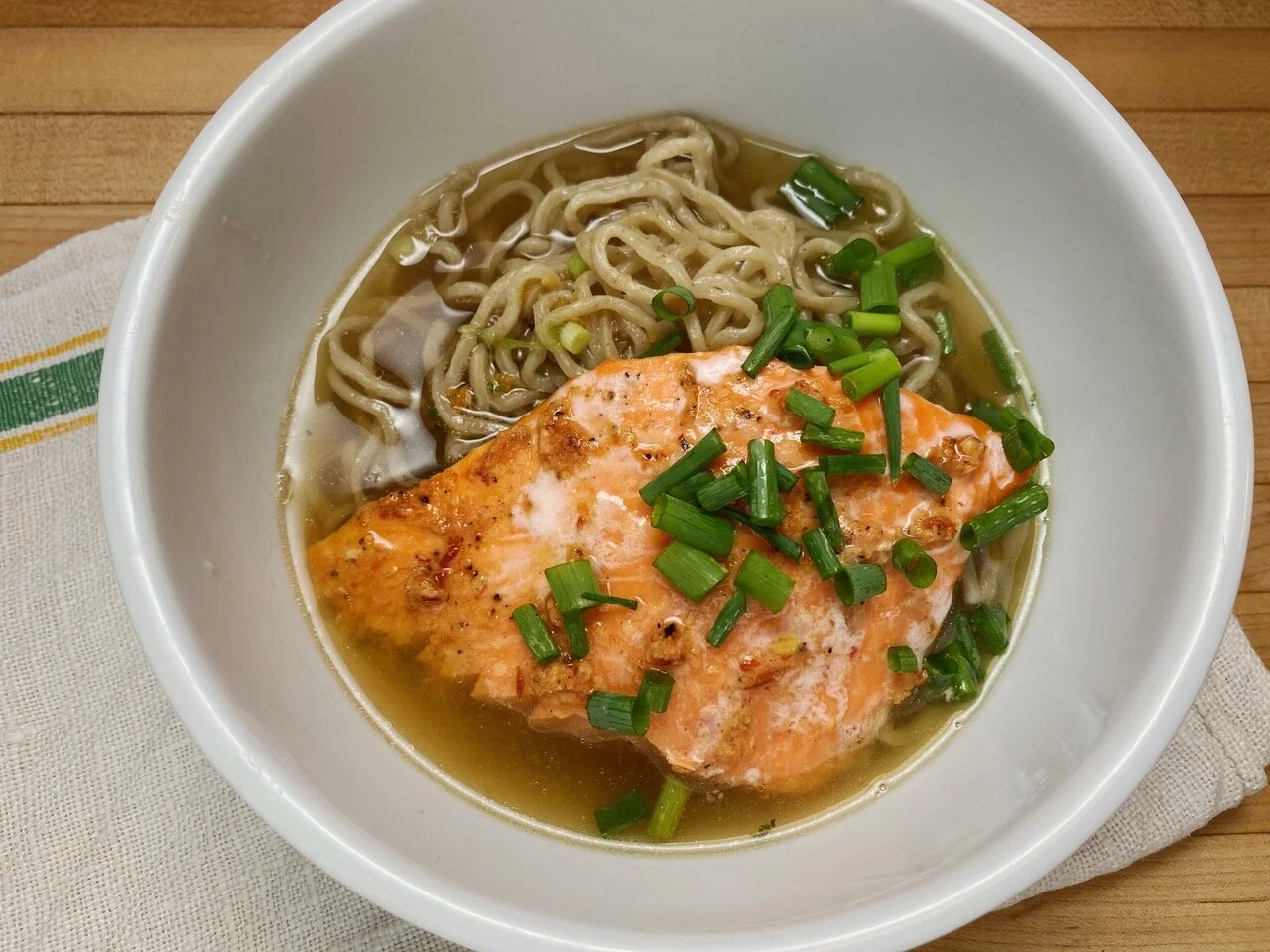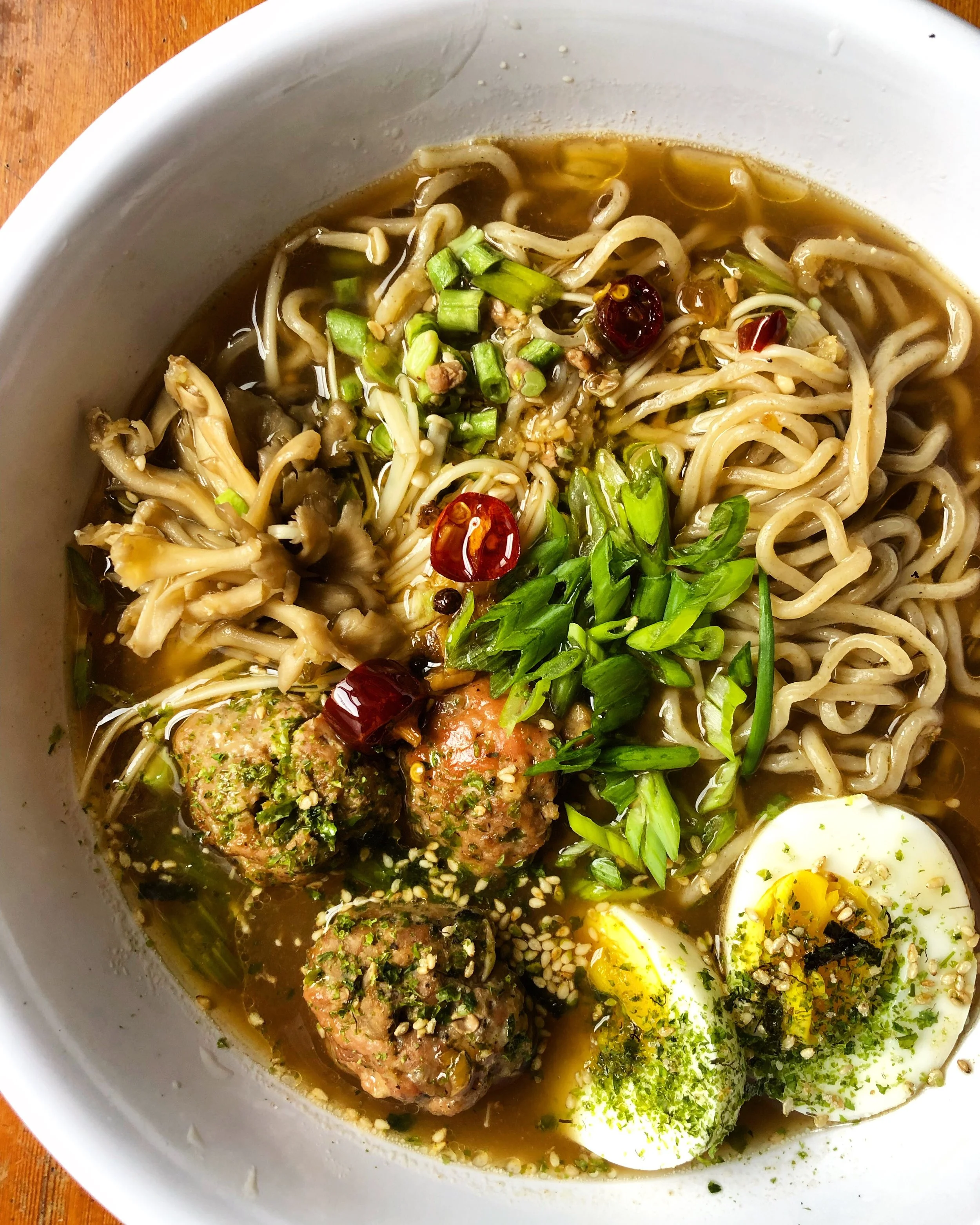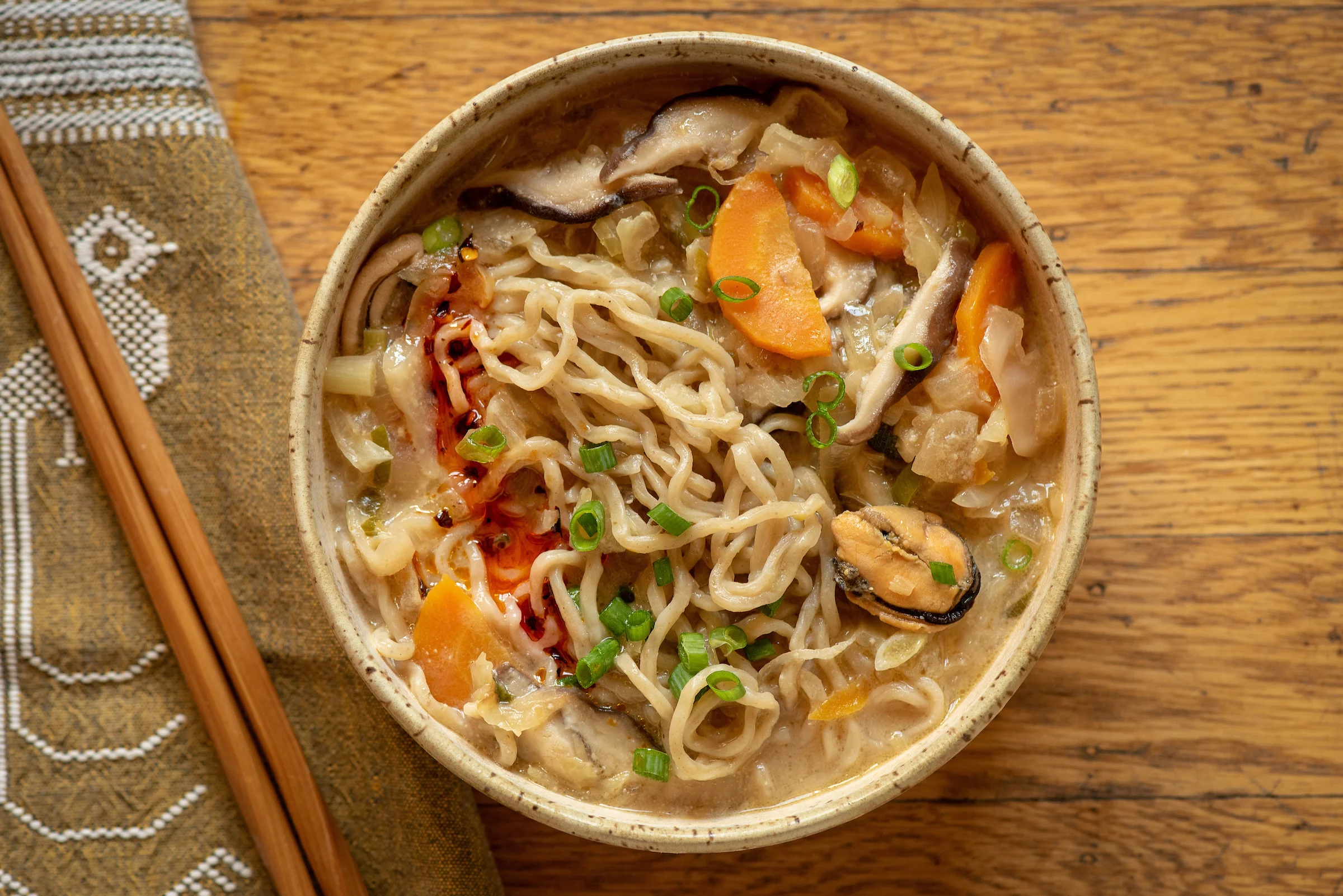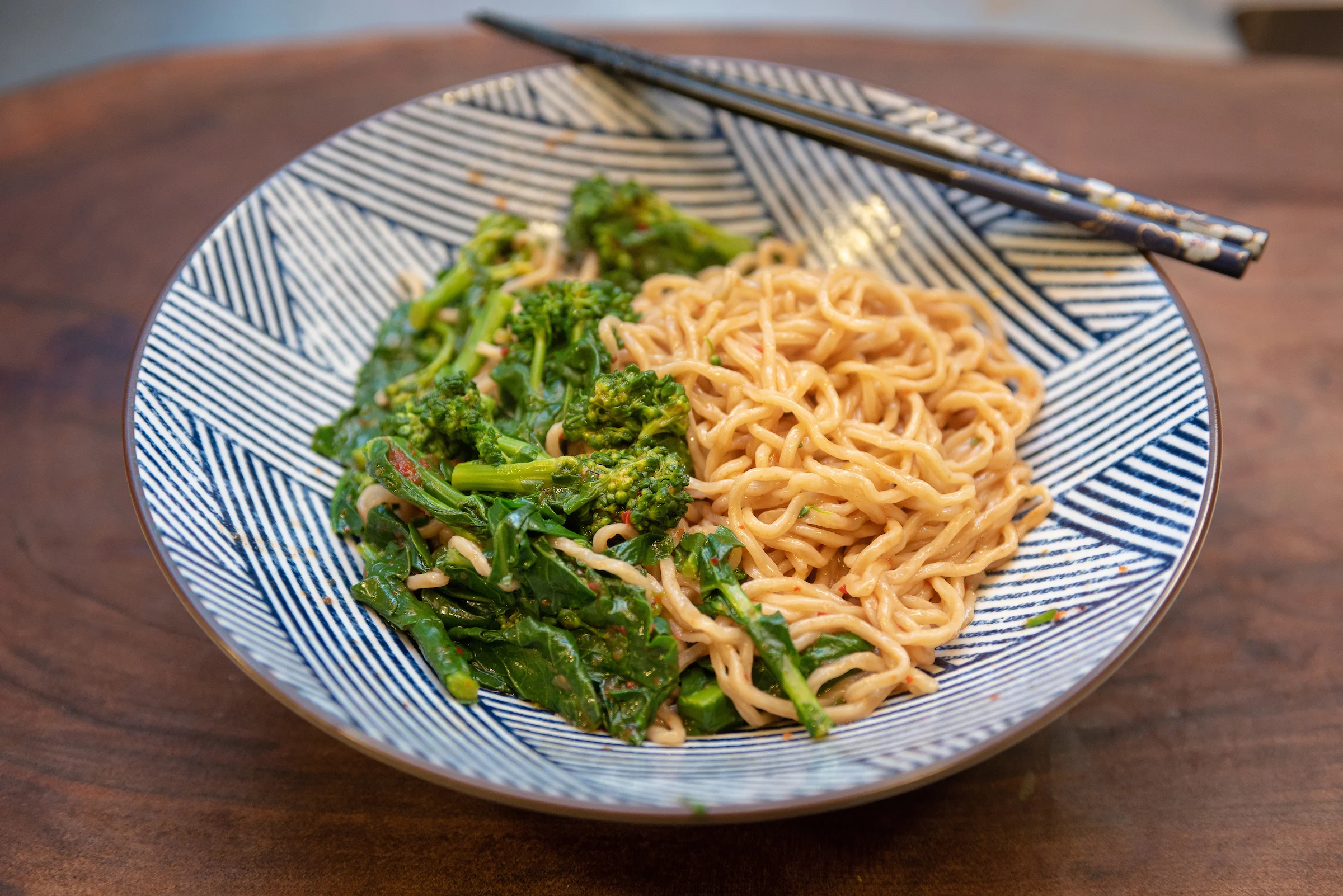Umi Ramen Noodle Recipes
The main idea here is to use your leftovers from preparing a traditional Thanksgiving meal (Turkey, stuffing, vegetables, cranberry sauce) and make them into bowls of ramen. Using leftovers is a huge timesaver and you can make a few things fresh if necessary to round out the dish. The broth alone will astonish you.
Miso and noodles belong together. Here are 6 recipes we turn to on the regular for simple weeknight meals that deliver a huge amount of satisfaction while also making us feel great.
Fortified with smoky lapsang souchong tea and blue fenugreek, this savory, traditional Central Asian meat-noodle soup is even heartier with Umi Organic ramen noodles. Though the dish comes from Central Asia, the name “lagman” comes from the same Chinese root word as ramen (lamian), making these two dishes ready for their Mongol-Turkic family reunion.
This dish of Umi ramen noodles with tempura'd veggies is really satisfying on a rainy evening. Seasoned with generous amounts of soy sauce and mirin, the broth is rich and sweet like tentsuyu (tempura dipping sauce) but still light enough to eat like soup. Swap mushroom broth for chicken stock and omit the fish to make this vegetarian.
I have often thought to myself, while eating this dinner, 'I could eat this every night!' That's how much I love it. Fried ground pork plays off of the tender tofu. There's spicy chilies and fresh green onion. This recipe came about because I started making mapo tofu, but over time adapted it to what I always have in my kitchen and what I know I love. And so this is kinda mapo tofu, and it is great!
Roasting mushrooms and vegetables kick starts a flavorful mushroom broth. The addition of a simple soy sauce or tamari flavor base, called a tare (pronounced tar-eh), transforms an already delicious broth into robust ramen soup.
This vegetarian miso ramen is extremely flexible. The basic idea is to make a quick 5-minute miso flavor base that transforms good stock into lip-smacking ramen broth. Store-bought stock is also a good substitute, and all toppings and garnishes are up to you.
"It was cold, wet and rainy growing up in the Pacific Northwest. This belly warmer has brought my spirits back after cold days in the outdoors. It is pure comfort."
Buttery, cheesy noodles with Sichuan, white, and black peppercorns. This is easy, satisfying comfort food.
This Thai pork sauce is out of this world. The flavors are so punchy, and it has the perfect amount of heat and funk. It's reminiscent of a bolognese, built on a base of ground pork, shallot, and tomatoes, with an addictive shrimp paste and fish sauce underbelly.
Annie made a wild discovery: Pan-fry our noodles with turmeric and they turn red! Why? Turmeric is a natural pH indicator. In contact with alkaline substances like our noodles, the orange-red carotene present in turmeric comes to the fore. Try it for yourself!
This recipe makes an extremely flavorful coconut broth infused with lemongrass, galangal, garlic, Thai chiles, and lime leaves. You may have to shop out of your way, but you'll love how easy this is to make: Chop everything in big hunks, drop into coconut milk, simmer, and strain.
"I adapted this recipe from a dish served at Eddie Lee's, a Portland restaurant that once occupied the space that's now Mother's. It features Chinese fermented, salted black soy beans aka douchi, often sold as 'preserved beans.' "
"This is a very simple, clean soup, and super efficient in its use of ingredients. You make stock from chicken, and then you use the chicken."
The combo of cream and chickpea or white miso is a little known secret. Just those two ingredients are unbelievably delicious together—salty, rich, deep, clean, lip-smacking. I can go on! Here, these two join a little sautéed garlic and some vegetables for a perfect, satisfying vegetarian Japanese pasta. It really does feel like Italian pasta reborn in Japan—the best of both worlds!
Kourtney Paranteau shares the newest entry to her cold weather repertoire: a curry noodle stew with butternut squash. The squash is added at the end as an equal to the noodles, and sits in the delicious tomato and coconut broth, adding another layer of texture and flavor. The broth is thick and stew-like but this vegetarian dish won’t drag your evening down with it.
Ready for a weekend project? Our friend Naomi Molstrom shares her recipe for delicious classic Japanese shio chicken ramen!
Naomi is the maser of inspiring from-scratch cooking. Chicken ramen is among Naomi’s favorites, and so we asked her to share some recipes. What follows is her chicken paitan broth and instructions on how to build a bowl. The word paitan means “white soup,” a reference to the cloudiness of the broth. As Naomi tells us, making broth is time consuming, but once everything is ready to use, making ramen is super quick. This is a recipe for someone looking for a kitchen project that yields a spectacular result.
“When I’m already assembling homemade dumplings, the extra labor of hand-making noodles isn’t worth the bragging rights, and Umi Organic’s ramen noodles remain the best store-bought ramen noodle I’ve encountered. This wonton soup rests handmade pork dumplings, bok choy, and bamboo shoots on a nest of Umi Organic Ramen Noodles, then floods the bowl with an aromatic ginger broth. This soup will sooth your lingering winter chills and surpass anyone’s cravings for chicken noodle soup.”
This recipe shared enthusiastically with us by Katherine Deumling of Cook with What You Have is incredibly simple, and that’s the beauty. You’ll have to start with a store-bought or homemade broth, but once that’s in the bag, the rest comes together easily. The salmon recipe, on its own, is a keeper! Katherine is right: The fresh ginger is the key here!
Honestly, we could just drink this soup as is. But it works beautifully with the noodles too, creating a big flavored vegan broth that clings to each strand. The center is creamy winter squash (we love the kabocha varieties) but ginger, kombu, and miso give the depth you need.
This ramen is such a great way to use up holiday leftovers. You’ve probably got stuff like mushrooms and green beans already in your fridge as we speak! In this case I’ve made the tsukune with ground turkey, but you could use ground chicken or pork, or your favorite vegetarian meatball.
A Japanese take on a classic home cooked fish chowder, with a cloudy, creamy broth and lots of fall vegetables. It’s comforting to its core.
A speedy, simple version of the classic Tantan Men. Somewhere between a soup and a saucy noodle, this version is super easy to whip up and very satisfying, hitting all kinds of rich and deep notes thanks to ground pork, tahini and miso. It feels very much like classic Japanese home cooking. The dried shiitakes are an especially nice addition.
The nice thing about miso ramen is that it’s rich enough for rainy days, but can be lightened up for spring by mixing up the veggies. My tare (seasoning liquid) starts with roasting a whole pig every year but I have a shortcut to a great pork broth too. Either way, go nuts!
We had the amazing fortune of meeting Jaron Ayres at the PSU Farmers Market on Saturday, and as he bought packs of noodles, he announced he was going to make a broth from a salmon head he had in his freezer. We were curious, and lo and behold, not 48 hours later, Jaron shared his photos and recipe with us. It looks down right good enough to eat.
Okinawan taco rice is totally a thing, and so is Korean cheese ramen, so why not? It's cold out, and sometimes you need to scratch two snacky comfort food itches at once. Feel free to use your favorite nondairy cheese and milk to make this vegan.
The foundation of this soup is a many-hour simmered beef bone broth that rumbles with depth and strength. We layered on top of that a carrot-ginger-fish sauce flavor base that is very bright, very lively, and a nice contrast to the beef. We really think this bowl is a winner!
This popular Japanese street food is the most hearty, lip-smacking cabbage pancake you could dream up, with layers of pork belly, crispy noodles, and a fried egg. It's a show stopper.
Tonjiru in a hearty winter miso soup made with bits and pieces of root vegetables and pork. It's a perfect way to use up vegetable peelings like carrot and potato skins. Add noodles, and this becomes an unusual but hugely satisfying ramen.
Are you the lucky owner of an Instant Pot? This is for you! Have a Dutch oven instead? This is for you too! A rich, deeply flavored stew for winter, redolent of star anise and cinnamon with a gentle heat from the chilies, and succulent, tender beef.
Kimchi stew is for kimchi lovers. The long simmer makes everything uniform and bright. The tofu is working some magic, we think. It is the perfect medium for taking up all that kimchi pungency and transforming the resulting stew into something strangely delicate.
Khao Soi is ramen’s cousin in Thailand—a thick, big flavored coconut broth typically served over egg noodles with a slick of coconut oil and chicken fat, pickled mustard greens to cut the richness, fried noodles for crunch, and lime and cilantro to add a refreshing kick.
“In its purest form, Bak Chor Mee are noodles lightly tossed in a sauce made with liquid lard, soy sauce, Chinese vinegar, and sambal. Then the noodles are topped with ground pork and other delicious toppings. I never really thought to make this until I discovered locally made Umi Organic ramen noodles. It's so good that it’s become a rotating family and friends meal favorite. On meat free days, I also make a delicious vegan version that is just as fun to eat and takes me down my Singaporean childhood food memory lane.”
“Shanghainese adore their noodles, and at one of my favorite hole-in-the wall noodle shops, I loved getting sesame noodles. During Covid, when we were all stuck at home, I was rummaging in the fridge and had an epiphany for a hack to make my favorite noodles: I used sesame hummus! It brought back many happy memories.”
There’s only one way to improve upon the pure culinary genius of birria ramen: use Umi Organic noodles. And you don’t have to use take-out birria consomé (broth) or spend hours making it—by using a pressure cooker and boneless stew meat, this pared-down version of the exquisite Mexican stew makes it a more weeknight-friendly endeavor without sacrificing any of the complexity.
This is my adaptation of a Fuchsia Dunlop recipe from her book The Food of Sichuan. She writes, “The following is my own re-creation of a legendary and unique version of dandan noodles served in a tiny restaurant near Sichuan University… These noodles are not for the faint-hearted—they are shamelessly spicy, but utterly delicious.” These dan dan noodles were even more satisfyingly delicious than I’d imagined AND it took almost no time to make, which shocked me. This is going to become a regular thing. If Fuchsia Dunlop’s is a re-creation, then mine is even one step further removed—an adaptation of a re-creation. I’ve changed some of the promotions I hope you will make it your own.
Alex and Nick, the duo behind Rangoon Bistro, teach us how to make a predecessor to Thai Khao Soi — a rich coconut-and-chicken based noodle soup flavored with turmeric and black pepper and thickened with chickpea flour. The result melts on your tongue and coats our noodles beautifully. The fresh, crisp toppings add a layer of engagement and brightness to the bowl.
This dish is smokey, salty, rich and sweet. It’s comforting and at the same time refreshing because of the fresh herbs. It’s great with any type of ground meat: try pork, chicken, or even tempeh. It whips together in about 20 minutes but has great complexity of flavor, falling into the category: I could eat this every day.
It was only appropriate that Anna Henricks, master of cakes, would make a noodle cake for us! Crispy on the outside, chewy on the inside, full of fresh herbs and great with a side of crunchy radish, this dish is perfect brunch food. It has elements reminiscent of dumplings, tortilla espanola, kugel, scallion pancakes. Whatever this cake is, we’ll take it, and with a side of flowers, please!
What we love about this recipe is its simplicity. “Quick, effective, and tasty!” as Ali says. It utilizes one of our all-time favorite cooking tricks: blanching broccoli, raab, or greens in boiling water at the same time you cook the noodles. They turn out perfectly cooked, and you have one less dish to wash. Since Umi noodles are naturally high in protein, this can be the simplest dinner of your week.
All over the world, springtime foods are about renewal, about fresh eggs, and the new green things sprouting from warming soil. In Frankfurt, Germany, this is celebrated with Grüne Soße, or green sauce, made with seven herbs: chives, borage, chervil, cress, parsley, sorrel, and burnet. In Hesse, this creamy sauce is served with boiled eggs and potatoes, but I think chewy Umi Organic ramen noodles are a perfect stand-in for the potatoes and that the sauce blends beautifully with chicken broth for a lovely, bright green soup.
Cooking Umi noodles is as quick and easy as boiling water and waiting two minutes. I do that every morning when I make coffee and toast bread. Thus was born the idea of Breakfast Ramen, a simple, satisfying breakfast where our noodles take the place of toast. Plus Umi nodles are chock full of protein, fiber, and iron, so you get all that extra nutrition to fuel you through your day.
We are going super simple with this breakfast ramen. You can literally make this on a weekday as quickly as you boil coffee and toast bread. Here is your no-fuss breakfast, full of healthy fats, high fiber and protein. Plus it tastes great. Enjoy!
Here’s our spin on avocado toast! Toss our protein, fiber, and iron rich noodles in a creamy avocado sauce that is reminiscent of pesto, creamy like alfredo, and full of all the good healthy fats and fiber that make avocado such a good start to your day.
Weekend brunch, noodle style! Here, bacon, homemade hash browns, and perfectly fried eggs top a bowl of Umi noodles dressed simply in butter and soy sauce. We take the best parts of an old standard and boost the fun.
This is a delicious, nourishing vegan noodle soup. For how great it tastes, it's surprisingly quick to make, in part because of one of our favorite kitchen hacks: cooking greens and noodles at the same time in the same water! This recipe comes to us from our favorite home chef, Katherine Deumling, whose seasonal recipe collection Cook with What You Have is our go-to spot for using local produce.
"I was inspired by the herbs in my garden and my love of crunchy things. The earthy noodles play very nicely with the bright herbs and the rich, toasted nuts."
"Pancit Palabok is garlicky pork and shrimp sauce over noodles. My Filipino neighbors growing up always made it for parties, and it was my favorite of the Filipino noodle dishes."
“I love a slurpy ramen soup but I also really love the chewy texture of ramen with a delicious sauce. I’ve been making a version of the meatball recipe for years as an appetizer and I was in the mood for some yummy ramen noodles and thought a play on the comfort of spaghetti and meatballs with an Asian-style flair would be fun. It was! And quite delicious!”
“This is a Filipino noodle dish that originated from the Chinese community that settled in the town of La Paz. Traditionally, it is made with pork and pork offal cooked in a beef and pork stock. It uses egg noodles and is topped with chicharron, fried garlic, scallions and a raw egg that cooks in the hot broth. It is a nourishing dish that is full of umami coming from a rich bone broth and shrimp paste. This is a variation of that dish I use at home made for how we live now and I find it is amazing with Umi Organic’s ramen because of the noodle’s amazing bite.
Our Umi miso pesto is smooth and creamy and works beautifully as a dressing for boiled noodles. The word pesto is a little misleading but the cornerstones are there: umami in the form of miso instead of parmesan; herbs, in this case cilantro instead of basil; nutty richness through sesame oil instead of pine nuts or walnuts; and richness through sunflower oil instead of olive oil. I like just Umi noodles tossed in pesto as a whole meal, but it’s great with some sliced ripe tomato in season, wedges of roasted winter squash, or something more substantial like panfried chicken or tofu.
Even during this unfathomably hot summer, I can’t go more than a few weeks without my favorite noodle dish tugging at my appetite: dandan noodles. I love dandan more than anything: chewy noodles tossed with ground pork and richly flavored with sesame paste and Sichuan peppercorn. To satisfy my year-round comfort food cravings, I’ve created a variation designed for the heat. This cold dandan noodle bowl features chilled Umi Organic ramen noodles and swaps the traditional preserved greens for a light, raw pea shoot salad.
I’ll be honest: This recipe Naomi shared with us is for a committed home cook. Why? Because the first step is to make shio dare, a flavor base used more often as the foundation for a bowl of hot ramen soup. If you don’t mind a small project, jump over to the shio dare recipe, make a batch, and then make this, which might be my favorite cold noodle salad that exists! (Once the shio dare is made, this is a literal breeze.) Naomi Molstrom goes all the way in her commitment to crunch. The chewiness of Umi noodles is so outstanding in this dish, and the contrast with all the crunchy vegetables makes this a textural delight.
Katherine Deumling of Cook with What You Have shares her recipe for an Umi noodle salad with peas, peanuts, cilantro and mint. It’s really perfect. It takes almost no time to cook (a gift on very hot days) and tastes refreshing and flavorful. This is your new go-to for noodle salad daze and days.
This recipe brings together our friend Chris’ smoky chili Pozole to the People broth with our ramen noodles! Why add ramen noodles to an already totally delicious dish? You have to love noodles, but if you do, the way the chili broth plays with them is something not to be missed! And honestly this is a completely satisfying meal that takes maybe 15 minutes to make. It will be like you were cooking all day, but actually, it was Chris who was!
We know it’s hard to believe, but ramen noodles are not only for the cold months! In fact, their chewiness shines in salads, where you can tangle them up with crunchy vegetables and have a meal that tastes great even in the heat. Here are 9 noodle salad recipes we turn to regularly in the summer.
Shallots and garlic simmered in ample olive oil and then combined with fish sauce, roasted red peppers, and chilies, heaped on a pile of noodles dressed with just soy sauce, vinegar, and honey. It turns out it tastes even more luxurious and addictive than it sounds.
A spicy, crunchy, delicious summer salad recipe shared with us by our friend Kathleen Bauer. Whip together the dressing in a blender, top with kimchi and crunchy cucumber, and you have a standout meal!
This sweet-sour-spicy cold Korean noodle dish is usually made with sweet potato noodles, but chewy Umi Organic ramen noodles are a serious upgrade. Korean cucumbers are ideal for this, but feel free to substitute Persian or English cucumber (a regular slicing cuke can also be used, but peel and seed it first). My sneaky trick for substantially expediting this meal is using a mandoline with a julienne blade!
This 20-minute dish was inspired by the fried chicken salad at Basilisk in Portland, but it’s equally good (maybe even better!) as a vegetarian meal with fried tofu. Leave off the egg and it’s vegan. It’s fast, satisfying, and perfect for a hot day.
Our friend Yuri concocted an original dressing for hiyashi chukka, that classic Japanese summer cold noodle salad with delicate slices of egg omelet, cucumber, and tomato. Being blasphemous, we sometimes substitute roasted beet for the tomato. She kindly shared her recipe, which features a surprise ingredient: almond milk. The dressing is simple to make: just whisk everything together. This is a refreshing one!
Few foods are better on a hot day than cold and spicy noodles. This dish is a heart-of-summer masterpiece. The sauce alone should always be in your fridge. It packs huge flavor. This recipe should make enough sauce for you to make this dish twice, so you can have an even easier dinner the next time around!
"This recipe is perfect for us college students looking for ways to cook with minimal time and ingredients! We'll usually toss in some sautéed veggies and tofu for a delicious and wholesome meal."
Dead simple weeknight fare. You can use your favorite sesame dressing if you don’t feel like whipping up the sauce.
"I make my own miso, so I am always experimenting with the best way to enjoy it. I often make this miso pork. I like the fact that I can put anything I have in my garden and refrigerator in this recipe, and it always turns out good!"
Flavor junkies, rejoice! This has the same appeal as Thai peanut sauce but with a rich sesame twist. Plus, it's as easy as whisking some pantry staples together, topping noodles with whatever you have on hand, and ladling sauce over the top.
"Nam Sodd is a favorite dish at my neighborhood Thai restaurant. I realized I could make it at home, and then I realized I could make it with Umi Organic noodles!"
"I love ramen, period. I love to eat ramen year round, rain or shine, hot or cold. The key to enjoying cold ramen is skimming fat off of the chicken broth very carefully and using Japanese dashi to add umami to the soup."
"The idea is minimal work and something for everyone. We set out all of the toppings to let people build their own noodle bowl."







































































I find mushrooms spectacularly delicious and satisfying. This dish highlights shiitake mushrooms—every single bite of noodles is tangled with a few mushrooms, which means every bite is a winner. While this recipe calls for shiitake, any number of mushrooms would work well in their place: oysters, criminis, lobsters, chanterelles—any mushrooms that tastes good sautéed in oil. This is now my favorite way to eat yakisoba noodles!